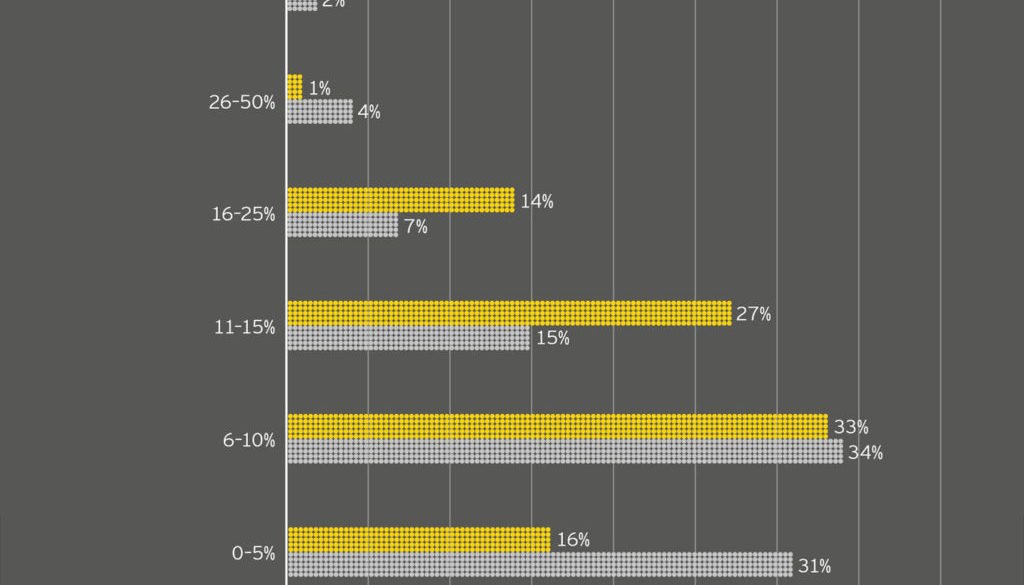Can shifting sands be a solid foundation for growth?
How India’s fastest-growing businesses are putting new technology at the heart of their growth agenda
Business confidence is robust among India’s middle-market leaders, despite global shock waves of demographic change, geopolitical uncertainty and technological disruption. Against a backdrop of economic reform to make it easier to conduct business in India, more than 4 out of 10 (41%) middle-market companies in India are predicting growth of 11%–25% — an impressive 8%–22% above World Bank Global GDP forecasts.
To deliver such strong growth, Indian middle-market leaders are seeking to harness new technology, expand across industries and borders, and attract millennial talent with flexible and innovative working environments.
These findings come from a new longitudinal global survey by EY of middle-market companies, which represent 99% of all enterprises worldwide and contribute almost half of global GDP. In India, as elsewhere, the middle market drives economic success, high-impact entrepreneurship and innovation. What is it about middle-market companies that enable them to accelerate growth? Are there lessons for all corporate leaders, whatever their business size?
The EY Growth Barometer explores middle-market leaders’ growth ambitions, strategies and challenges, and attitudes to global risks and uncertainties. The survey covers 2,340 C-suite executives in businesses with revenues of US$1m to US$3b, as well as selected high-growth companies less than five years old.
1. EY commissioned Euromoney Institutional Investor to undertake an online survey of 100% C-suite (60% CEOs, founders or managing directors) in companies from 30 countries and with annual revenues of US$1m–US$3b. The survey was conducted from 31 March 2017 to 12 May 2017. The 2,340 respondents are geographically representative of global GDP (as per World Bank 2016 data). EY further invited our global network of EY Entrepreneur Of The Year™ alumni to take the survey. The survey was available in English and six other languages. Further in-depth interviews were carried out during May 2017 to provide additional specific insights.
World-beating growth
The growth predictions of middle-market leaders in India surpass the rest of the world. More than one-quarter plan current year growth of 11%–15%, with a further 19% intent on growing between 16% and 50% — far higher than both the World Bank’s global GDP forecast of 2.7% and its prediction for India of 7.2%.
This business confidence reflects the political stability and reform agenda of the Modi Government, says Sibjyoti Basu, EY India Growth Markets Leader. “There is enduring optimism in the country, with the tax and fiscal reform program making it much easier to do business, in spite of the recent short-term deceleration in India’s GDP growth rates,” Basu says. “The increase in consumption of the growing middle class remains very positive for the middle market.”
The Indian middle market’s growth strategy of choice is increasing market share — it is the main priority for 23%, against 17% globally. This focus on market share is shared by the leaders of the world’s fastest-growing companies. Interestingly, Indian business leaders rate their joint-second strategy, entry into a new geographical market, much lower than the global cohort that ranks it first — 17% compared with 24% in the rest of the world. It’s possible the Indian middle market is focusing more on domestic growth, as its other joint-second strategy is business consolidation through divesting non-core interests at 17%, compared with 12% elsewhere.
Unleashing India’s potential
Middle-market companies in India, like the rest of the world, see increasing competition as the greatest risk to growth (21%), followed by geopolitical instability (17%). The fact that the nation’s business leaders focus more on what they can shape — their place in the market — rather than affairs outside their control, brings home the resilience and dynamism of the market segment. The third greatest perceived risk in the Indian middle market is regulation and/or trade barriers at 15%, higher than the global figure of 12%. This may partly mirror concern over the introduction of India’s goods and service tax (GST), as some see it as the catalyst that will unleash India’s potential, while others fear it could spark higher inflation and a collapse in consumer confidence.
When it comes to internal challenges, Indian middle-market leaders see insufficient cash flow as their biggest problem (16%), slightly higher than the global figure (15%). However, India is distinguished from other “tiger” economies by limited concern over the cost/availability of credit —prioritized by just 9%, compared with 12% globally — and access to capital.
Profitability is the main driver of innovation, ranked by 23% of business leaders in India compared to 19% in the rest of the world, with margin or profit improvement ranked second, after return on investment. And with their eye on cost containment, Indian C-suite leaders ranked supply chain and operations efficiency as one of the top two routes to a successful growth strategy.
Harnessing new technology
Technology is a huge part of India’s growth story, with the nation’s status as a global innovation hub growing each year. The country’s C-suite leaders see technology as both a hurdle and an enabler, ranking it the greatest challenge to growth, along with cash flow, and the second most disruptive global megatrend. But they also consider technology as the most essential contributor to growth, whereas the rest of the world put it third.
The Indian middle market’s ability to harness new technology is seen in its early adoption of robotic process automation (RPA). Ten percent of the country’s middle-market businesses are already using this technology, compared to just 5% globally, with a further 16% planning to do so in the next two to five years. Overall, Indian middle-market leaders do not see RPA as a harbinger of huge job losses, contrary to dystopian predictions. Most think it will lead to staff reductions of less than 10%.
Reflecting their bullish growth plans, the Indian middle market is on a major recruitment drive. More than one-third (36%) of respondents plan to increase their full-time staff numbers, compared to 27% globally, with 16% looking to take on more part-timers. Indian middle-market businesses are also embracing the flexibility of the gig economy, with 20% intending to hire more contractors or freelance staff, slightly higher than the rest of the world (18%).
Like their global peers, Indian middle-market companies particularly want people with specialist skills who are an excellent cultural fit.
“What we are trying to achieve is akin to running a marathon. It’s not a sprint,” says Ajit Dayal, founder and former director of Mumbai-based asset manager Quantum Advisors. “Part of the challenge we face in achieving our aim is in hiring the right people who not only fit with the culture and share our values, but who will also work for us and understand that they are going to be paid less than what other firms in the same business could pay them. Those firms are running a different business to us.”
However, even in a country with a large, young population, lack of skilled talent is ranked as a significant challenge by middle-market leaders (14%, same as globally). With the Indian economy growing so rapidly, companies are experiencing a new demand for highly skilled workers — an inevitable by-product of the country’s more global perspective. The Indian Government is seeking to address this issue through increased investment in education, vocational learning and skills development, notably through its Skill India initiative.3 When it comes to skills, leadership capability is a particular demand for the country’s middle-market companies: people with leadership skills are ranked as one of their top three talent needs.
Attracting skilled millennials
Changing times require different workplaces. With 65% of the population under 35 and half under 25,4 it is unsurprising that Indian executives rank demographic shifts as the most disruptive global megatrend — 36% against 34% globally. Basu says that to attract and engage young talent, employers must provide creative and innovative workplaces.
“Millennials have a different attitude to work than previous generations,” says Basu. “Young people now have many more options and are more driven by things like a company’s culture and style of organization.” Recognizing this imperative, Indian middle-market leaders say an improved organizational culture is the primary factor in boosting productivity, while instilling a company purpose comes third.
Indian middle-market leaders are ahead of the pack in their customer focus. Using customer data to drive innovation from the bottom up is the main strategic priority for 22%, compared with 17% globally. In this they again resemble the world’s fastest-growing companies, which also prioritize this approach. Similarly, almost one in five (19%) Indian respondents say customer demand drives innovation, against 15% globally.
However, the Indian middle market is less convinced that successful growth depends more on the strength of a company’s wider network — including customers, suppliers, partners, influencers and even competitors — than its internal capabilities. Just 74% of Indian business leaders hold this view, compared with 86% globally. This may reflect an independence of spirit among Indian middle-market leaders that discourages collaboration.
While laudable, such self-reliance can inhibit greater knowledge, capability and growth. In the context of the Indian FinTech sector, Bhavik Vasa, Chief Growth Officer of Indian payments solutions company ItzCash, says businesses need to “collaborate rather than compete. … Instead of being independent entities trying to be one up in this space, collaborating in terms of innovative ideas and solution approach will bring in a far better ecosystem from India. … Collaboration is key, and spreading awareness will help … scale and grow, not just in the domestic matter but globally.”
Planning for future growth
How much of your time is spent on running the current business vs. future strategy? What should be the ideal split?
Keeping ahead of a fast-changing world requires a lot of future-gazing, and the Indian middle market recognizes its importance. Whereas most executives around the world spend 80% of their time on current operations and 20% on strategic planning, in India the majority spend 40% of their working day planning for the future. And while most of the global cohort think they should spend more time planning ahead than they do, a majority Indian middle-market leaders think they have already got the balance right.
“The faster the pace of change and the higher the growth ambitions, the more time businesses leaders need to devote to strategic planning,” says Basu. “Indian executives realize this and, like other fast-growers, are spending more and more time planning for future growth.”







